Recent Water Damage Posts
Common Mistakes Homeowners Make That Lead to Water Damage
10/16/2024 (Permalink)
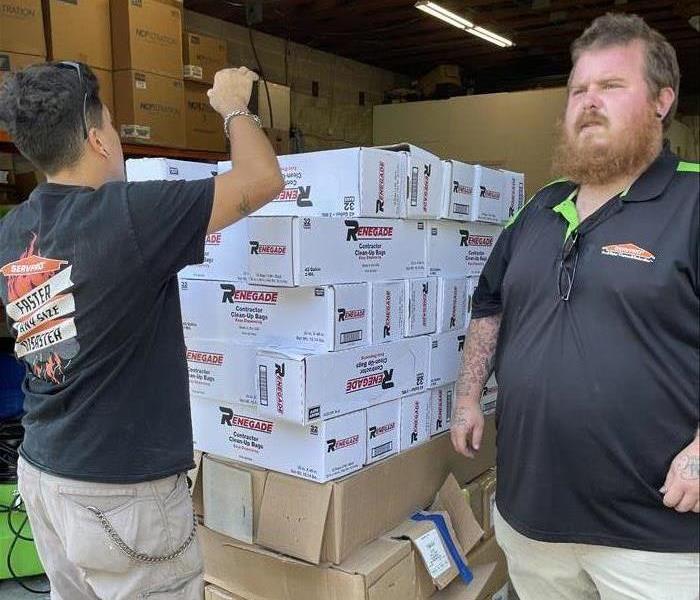 Remember, being proactive today can save you from extensive damage and costly repairs tomorrow.
Remember, being proactive today can save you from extensive damage and costly repairs tomorrow.
Water damage is one of the most common issues homeowners face, and unfortunately, it often results from preventable mistakes. At SERVPRO®, we have seen firsthand how small oversights can lead to costly and extensive repairs. By being aware of these common mistakes, you can take proactive steps to protect your home from water damage.
Ignoring Minor Leaks
One of the most common mistakes homeowners make is ignoring small leaks. Whether it’s a dripping faucet, a minor roof leak, or a tiny crack in a pipe, these issues are often dismissed as insignificant. However, what starts as a minor leak can quickly escalate into a major problem. Water that continually seeps into your home can cause structural damage, encourage mold growth, and ruin your belongings. The best approach is to address leaks as soon as they’re noticed. Regular inspections of your plumbing, roof, and other vulnerable areas can help you catch leaks early and prevent more severe water damage.
Poor Drainage Around the Home
Another common mistake is neglecting proper drainage around the home. Poor drainage systems, such as clogged gutters or improperly sloped landscaping, can cause water to accumulate around your foundation. Over time, this can lead to basement flooding, foundation cracks, and significant water damage inside your home. To avoid this, ensure that your gutters and downspouts are clean and direct water away from your house. Additionally, consider grading your yard to slope away from the foundation, which will help keep excess water at bay.
Mismanaging Appliance Maintenance
Home appliances, particularly those that use water, are often a source of water damage when not properly maintained. Washing machines, dishwashers, water heaters, and refrigerators can develop leaks due to worn-out hoses, faulty seals, or general wear and tear. Homeowners often overlook regular maintenance of these appliances, leading to unexpected water damage. It’s essential to routinely inspect these appliances for signs of wear and tear and replace any damaged components promptly. Installing a water leak detection system can also provide an added layer of protection by alerting you to potential leaks before they become significant issues.
Delaying Roof Repairs
The roof is your home’s first line of defense against water damage, but many homeowners delay repairs when they notice issues like missing shingles, damaged flashing, or deteriorating seals around vents and chimneys. Ignoring these problems can lead to significant water intrusion during storms, causing damage to your attic, walls, ceilings, and even the structure of your home. Regular roof inspections, especially after severe weather, and timely repairs can prevent water from finding its way into your home.
Water damage can be costly and disruptive, but by avoiding these common mistakes, homeowners can significantly reduce their risk. Regular maintenance, prompt repairs, and proper home management are key to keeping your home safe and dry. At SERVPRO®, we’re here to help® you prevent water damage and assist with restoration if the unexpected happens. Remember, being proactive today can save you from extensive damage and costly repairs tomorrow.
Foundation Cracks and Water Infiltration: Causes and Fixes
6/12/2024 (Permalink)
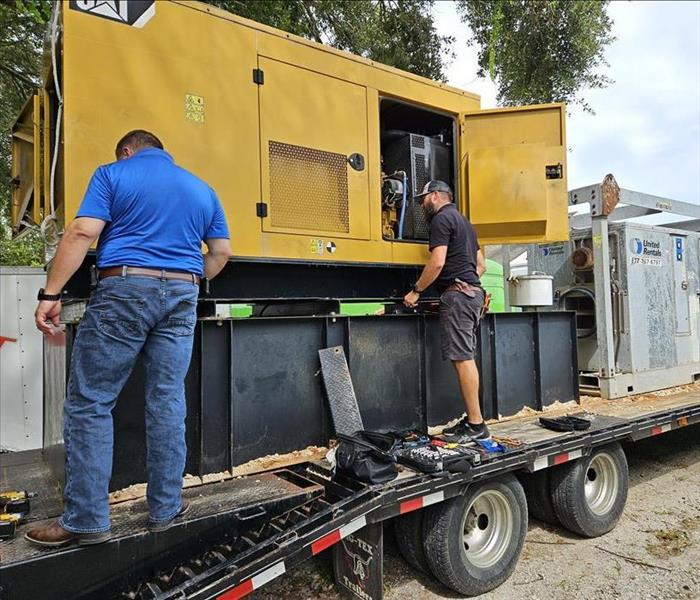 We will explore the common causes of foundation cracks and provide helpful fixes to address water infiltration issues.
We will explore the common causes of foundation cracks and provide helpful fixes to address water infiltration issues.
The foundation of your home is not only vital for its structural integrity but also for protecting it from water infiltration. However, foundation cracks can compromise this protective barrier, allowing water to seep in and cause significant damage. Understanding the causes and finding effective solutions for foundation cracks and water infiltration is crucial to preserving the health of your home. Here, we will explore the common causes of foundation cracks and provide helpful fixes to address water infiltration issues.
Causes of Foundation Cracks
- Soil Settlement: Over time, the soil beneath your foundation can settle, leading to uneven pressure and causing cracks to develop.
- Poor Drainage: Improper or inadequate drainage around your home can result in water pooling around the foundation. This constant exposure to moisture can weaken the foundation and lead to cracks.
- Hydrostatic Pressure: Excessive water pressure from saturated soil can push against the foundation walls, causing them to crack under the strain.
- Temperature Changes: Extreme temperature fluctuations can cause the foundation to expand and contract, leading to cracks.
Fixes for Foundation Cracks and Water Infiltration
- Evaluate Drainage System: Ensure that your home's drainage system is properly designed and functioning effectively. Clear gutters and downspouts regularly to prevent water overflow. Consider grading the soil around your foundation to direct water away from the house.
- Install a Sump Pump: A sump pump can be an effective solution to manage water intrusion. It collects excess water and pumps it away from the foundation, minimizing the risk of water infiltration through cracks.
- Seal Foundation Cracks: Smaller cracks can be sealed using epoxy or polyurethane-based sealants. These sealants fill the cracks and prevent water from entering your home. However, it's essential to note that this is a temporary fix and may not be suitable for larger or more severe cracks.
- Professional Foundation Repair: For significant or recurring foundation cracks, it's advisable to consult with a professional foundation repair service like SERVPRO®. They can assess the extent of the damage, determine the underlying cause, and recommend appropriate solutions. Professional repairs may involve techniques such as concrete underpinning, carbon fiber reinforcement, or helical piers to stabilize the foundation and prevent further cracking.
- Maintain Consistent Moisture Levels: Keep the soil around your foundation consistently moist to reduce the risk of shrinking and expanding, which can cause foundation cracks. Avoid overwatering or allowing the soil to dry out completely.
- Monitor and Address Minor Cracks: Regularly inspect your foundation for any signs of cracking or water infiltration. Promptly address minor cracks by sealing them to prevent further water damage and potential structural issues.
- Landscaping Considerations: Plant trees and shrubs away from the foundation, as their root systems can grow and exert pressure on the foundation walls, leading to cracks. Additionally, avoid overwatering landscaping near the foundation.
Foundation cracks and water infiltration can be a serious concern for homeowners. By understanding the causes and implementing effective fixes, you can protect your home from water damage and preserve its structural integrity. Remember to evaluate drainage systems, seal cracks, and consult with professionals for more extensive repairs. By taking proactive steps and working with trusted experts like SERVPRO, you can ensure the long-term health of your foundation and overall home. Act promptly, address issues as they arise, and safeguard your home against potential water infiltration and its damaging effects.
4 Reasons Why Immediate Action After Water Damage is Important
2/22/2024 (Permalink)
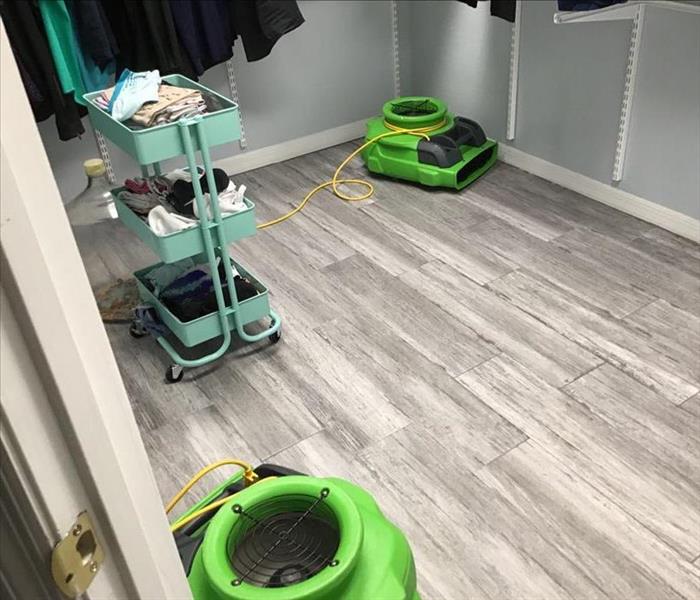 At SERVPRO of Punta Gorda, our team is equipped with the expertise and resources to respond immediately to water damage emergencies.
At SERVPRO of Punta Gorda, our team is equipped with the expertise and resources to respond immediately to water damage emergencies.
Water damage can strike unexpectedly, wreaking havoc in your home or business. In many cases, water damage can stay hidden for an extended period of time. Acting quickly is crucial in mitigating the effects of water damage and preventing further damage. Here are four reasons why time is of the essence after water damage occurs.
1. Preventing Mold Growth
Within as little as 24 to 48 hours after water intrusion, mold can start to develop in damp environments. As moisture migrates throughout your property, so does mold infestation. Mold growth not only compromises indoor air quality but can also cause significant damage to your property.
2. Limiting Structural Damage
Water can seep into walls, flooring, and other structural elements, weakening their integrity over time. Prompt extraction, drying, and restoration help prevent long-term structural damage. Delayed action can lead to expensive repairs or even structural failure in severe cases.
3. Preserving Belongings and Valuables
Furniture, electronics, documents, and sentimental items are very susceptible to irreparable damage when exposed to water. Quick intervention and professional restoration services increase the likelihood of salvaging these items, and preserving your valuables.
4. Lower Restoration Costs
Time-sensitive water damage mitigation is cost-effective. Immediate action reduces the extent of damage, thereby minimizing restoration costs. Delaying response may escalate the damage, resulting in higher expenses for remediation and repairs.
Don't hesitate when water damage strikes. At SERVPRO of Punta Gorda, our team is equipped with the expertise and resources to respond immediately to water damage emergencies. Our rapid response mitigates further damage, ultimately saving you time, money, and stress.
Remember, time is truly of the essence after water damage occurs. Trust our SERVPRO® team to be your partner in restoring your property to its pre-damage condition. Act quickly, restore promptly – SERVPRO® is here to help.
What You Need to Know About Flood Plains and Water Damage in Punta Gorda
10/9/2023 (Permalink)
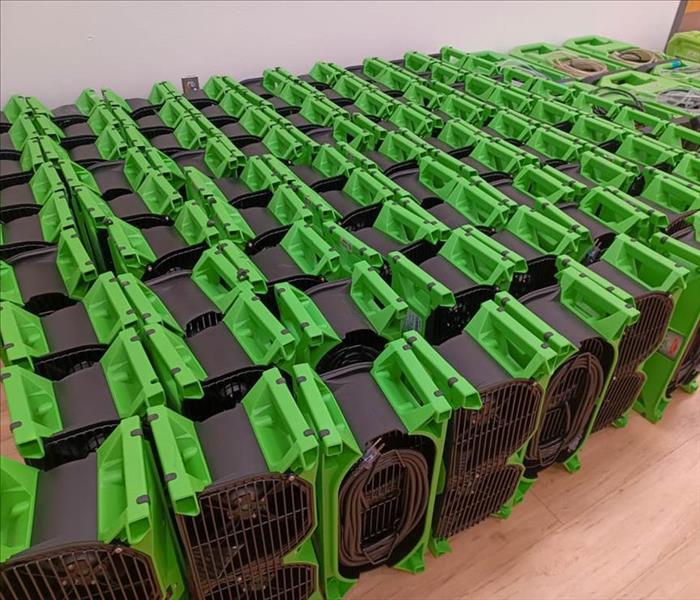 It's essential to be prepared for the potential risks associated with flood plains and water damage.
It's essential to be prepared for the potential risks associated with flood plains and water damage.
Nestled along Florida's beautiful Gulf Coast, Punta Gorda offers residents and visitors a picturesque paradise. However, living in a coastal area comes with its unique challenges, including the risk of flooding. In this blog, we'll explore flood plains and water damage in Punta Gorda, providing valuable insights to help you understand your area better and take proactive steps to safeguard your property.
Flood Plain Basics
Punta Gorda, like many coastal regions, has designated flood plains. These are areas prone to flooding during heavy rains, storms, and hurricanes. Understanding whether your property is in a flood plain is the first step in assessing your flood risk
Flood Risk Assessment
Knowing your flood risk is crucial. The Federal Emergency Management Agency (FEMA) provides Flood Insurance Rate Maps (FIRMs) that outline flood zones and risk levels. Consult these maps to assess your property's risk and consider purchasing flood insurance.
Flood Insurance
Standard homeowners' insurance policies typically do not cover flood damage. If you're in a flood-prone area, securing flood insurance is essential. It provides financial protection and peace of mind in the event of water damage from flooding.
Flood Preparedness
Prepare for potential flooding by creating an emergency kit, having a family emergency plan, and elevating valuable items. Being proactive can minimize damage and ensure the safety of your loved ones.
Mitigating Water Damage
Even if your property isn't in a designated flood plain, heavy rains and storms can still lead to water damage. Invest in preventive measures like proper drainage, maintaining your roof, and sealing vulnerable areas to prevent water intrusion.
Professional Restoration Services
In the unfortunate event of water damage, trust professional restoration services like SERVPRO® of Punta Gorda to assess and mitigate the damage promptly. Our expertise in water damage restoration can help salvage your property and belongings.
Living in Punta Gorda offers incredible coastal living, but it's essential to be prepared for the potential risks associated with flood plains and water damage. By understanding your area's flood risk, securing flood insurance, preparing for emergencies, and investing in preventive measures, you can protect your property and loved ones. Remember that SERVPRO® of Punta Gorda is here to assist with professional water damage restoration whenever needed. Stay informed, stay prepared, and enjoy the beauty of Punta Gorda with confidence.
Clearing a Clogged Pipe: A Step-by-Step Guide for Quick and Effective Results
7/13/2023 (Permalink)
Dealing with a clogged pipe can be a frustrating and inconvenient experience. However, knowing how to properly clear a clogged pipe can save you time, money, and the hassle of hiring a professional plumber. In this blog post, we will provide you with a comprehensive guide on how to tackle a clogged pipe effectively, ensuring a smooth flow of water and preventing future blockages.
Assess the Severity of the Clog
Before diving into clearing the clogged pipe, assess the severity of the blockage. Is it a minor or major clog? This will help determine the appropriate method to employ. For minor clogs, you can try simpler solutions, while major clogs may require more advanced techniques or professional assistance.
Use a Plunger
For minor clogs in sinks or toilets, a plunger can be your first line of defense. Ensure there is enough water to cover the plunger's rubber head and create a tight seal over the drain. Plunge vigorously, pushing and pulling to create suction and dislodge the clog. Repeat the process several times if needed. After plunging, run water to check if the clog has cleared.
Try a Natural or Chemical Drain Cleaner
If the plunger doesn't work, consider using a natural or chemical drain cleaner. Natural options include pouring a mixture of baking soda and vinegar down the drain, followed by hot water. Alternatively, you can use a commercial drain cleaner, following the manufacturer's instructions carefully. Keep in mind that chemical drain cleaners can be harsh and should be used sparingly and with caution.
Implement Mechanical Methods
If the clog persists, mechanical methods can be effective. A drain snake or auger is a flexible tool that can reach deep into the pipe and dislodge the clog. Insert the snake into the drain and rotate it clockwise while pushing forward. When encountering resistance, rotate and push to break up the blockage. Slowly pull the snake out, ensuring the clog is cleared. Remember to clean the snake thoroughly after use.
Prevent Future Clogs
Prevention is key to avoiding future clogs. Implement simple measures such as using drain strainers to catch debris, avoiding pouring grease or oil down the drain, and regularly flushing drains with hot water. Also, be mindful of what you flush down toilets, as items like sanitary products or wipes can lead to clogs. Regular maintenance, such as snaking the drains or using enzymatic cleaners, can help prevent buildup and maintain smooth-flowing pipes.
Clearing a clogged pipe doesn't always require professional assistance. By following these steps to assess the severity of the clog, using a plunger, trying natural or chemical drain cleaners, employing mechanical methods like a drain snake, and implementing preventive measures, you can effectively clear clogs and maintain the proper functioning of your plumbing system.
Why Does My Toilet Leak Every Time I Flush?
11/5/2022 (Permalink)
What To Do When Your Toilet Is Leaking?
If you have a leaky toilet every time you flush, your first thought may be that the toilet needs to be replaced. Sometimes this is true, but there are other factors that can cause leaks that don't involve replacing the entire system.
In this article we'll cover some common causes of leaking toilets and what you can do about them.
Issues with the tank and the toilet installation.
The tank is installed too low. The most common cause of this issue is a misaligned wax ring, which you can read about below.
The toilet is not level. This can be caused by a loose installation or an old wax ring that has become misshapen over time, and it's remedied by simply adjusting the toilet until it's level again.
The wax ring isn't properly installed or broken. A high-quality wax seal around the base of your toilet will prevent leaking from occurring, but this seal needs to be kept in good condition if you want to avoid leaks entirely—if there are cracks or tears in the old seal, then water can seep under them and leak out into your bathroom every time someone flushes their toilet!
Your toilet itself may be broken; check for any loose parts inside your tank before proceeding with any other repairs (and make sure everything looks like it should).
Your tank flange might also need replacing; if so, contact us today at (941) 575-5910 and we'll help get things flowing smoothly again!
Dry wax ring or improper installation
Sometimes a wax ring can dry out and need replacing. A wax ring is the seal between your toilet base and the floor. If your wax ring is cracked or broken, water will leak from under your toilet every time you flush it.
This can be corrected by simply replacing the wax ring with a new one. This should be done every 5-7 years, or if there has been any plumbing work done in that area of your bathroom (such as removing tiles).
Tank flange can be broken or tank not tightened
If your toilet flushes and leaks water, the problem could be that your tank flange is broken or not tightened correctly. To fix this issue, you'll need to tighten it and/or replace it if necessary.
SERVPRO of Punta Gorda
You can count on SERVPRO of Punta Gorda to be ready to respond 24/7, with emergency services available any time you need us. Whether you have a full-scale emergency or a simple plumbing leak, we’re dedicated to being fast and thorough when restoring your home. SERVPRO is the #1-rated water damage company in the U.S., and we provide professional, certified technicians using advanced equipment for the best possible outcome. We can help you with:
- Professional water removal
- Expert drying procedures
- Mold remediation
The good news is that a leaky toilet can be fixed. Whether your leak is coming from the tank or the bowl, SERVPRO of Punta Gorda can help you. We have years of experience dealing with all types of leaks and can get your home back in order quickly by using advanced water damage restoration techniques. Our team will assess the damage and provide you with a plan so that your home doesn’t suffer even more damage while we work on fixing it up!
What Should You Do After Your Basement Floods?
4/25/2022 (Permalink)
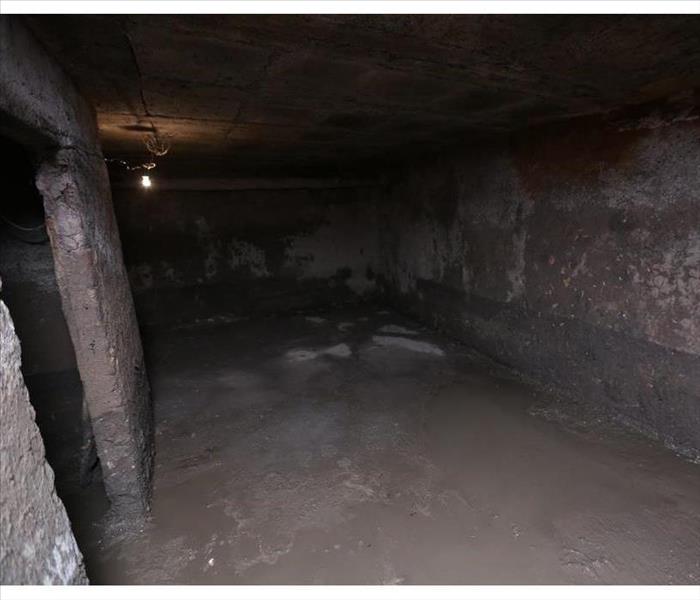 Any valuable items or devices stored in the basement may be damaged or destroyed by a flood. Acting quickly is the best way to protect your property.
Any valuable items or devices stored in the basement may be damaged or destroyed by a flood. Acting quickly is the best way to protect your property.
What Can You Do If Your Basement Floods?
A basement flood has the potential to damage and destroy any valuable items and devices stored there. The best way to protect your property is by acting immediately if possible. If the area is not too flooded and there is no immediate danger such as electricity, you can take the following steps to reduce the impact.
1. Find and Fix the Source
There are multiple reasons why your basement can flood. Perhaps an appliance such as laundry machine malfunctioned and leaked water or cracks in the foundation seeped water inside after a heavy storm. If it is safe to navigate the area, try to locate the source. You may fix the problem if it is something small such as cracks or loose piping. However, call a plumbing professional if the problem is too complex to handle or if the area is too full of water.
2. Remove Any Valuables
Another concern during a basement flood is the status of your property. Floodwater will damage and contaminate your items, especially ones made of fabrics, cardboard and other vulnerable materials. Wear gloves and boots when retrieving any items you can take. Take photos and other information that you can use for the insurance coverage and the water damage repair. Avoid lifting heavy items, especially if the location is still too flooded.
3. Drain and Dry the Area
Some floods are more severe than others. If the water is less than two feet and the leaking has stopped, you can remove it using tools like a wet vacuum, mops and towels. Otherwise, have the remediation team tackle the issue. Avoid mold growth and extended damage by drying the basement. Open doors and windows to improve air circulation. Use fans and dehumidifiers to decrease the humidity and reduce the potential damage costs.
Flooding can be a costly disaster, especially in rooms where you keep important items. Use these tips to act fast during a basement flood and contact Punta Gorda, FL, professionals to assist you.
What Is Secondary Water Damage?
3/14/2022 (Permalink)
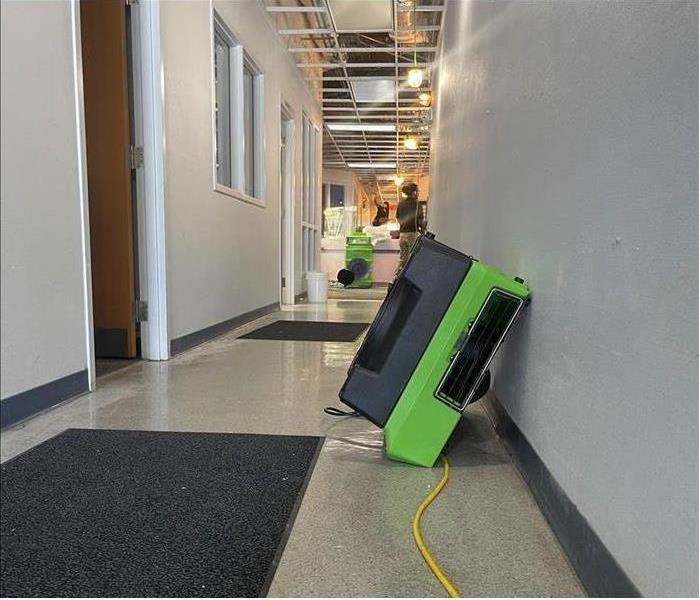 SERVPRO is highly trained and experienced in water damage cleanup and restoration and we are always here to help, no matter the day or hour.
SERVPRO is highly trained and experienced in water damage cleanup and restoration and we are always here to help, no matter the day or hour.
What Exactly Is Secondary Water Damage?
When a building undergoes a water incursion, people tend to only think about the standing water itself. However, when the water is left to sit, it can cause additional damage, such as black mold growth, which can often cause even more damage than the water. This is called secondary damage, which can occur in several forms.
1. Electrical
Severe damage can occur when water gets in electrical sockets. If you suspect that this has happened, stay out of the area until a professional can inspect it; electrical shocking is a risk.
2. Wood Rot
Organic material, such as wood, is susceptible to rotting when water is introduced. Wood rot can lead to significant structural problems.
3. Mold
Mold doesn't need much to grow. Since mold spores are already nearly everywhere, all they need is high humidity and a food source. Black mold is one of the most common types. It can begin growing in as little as 24 hours and can spread quickly throughout the building.
4. Flooring
Standing water can cause flooring such as hardwood and laminate to buckle. There's no way to repair them when this happens. Soaked carpet usually won't be able to be thoroughly dried quickly enough. Most of the time, flooring must be removed and disposed of. Water can get trapped under the flooring, which can cause even more problems in addition to the flooring itself, such as mold growth and damage to the padding and subfloor.
5. Corrosion
Corrosion can begin when metal materials (e.g., pipes and studs) come into contact with water, even with high humidity. The metal can disintegrate, causing even more damage.
Suppose your building sustains water damage in Charlotte Park, FL. In that case, whether it's from a spontaneous flood or a slow leaking pipe, it's crucial to immediately stop the water and begin the remediation process. If caught soon enough, quick action can prevent black mold growth and other secondary damage.
3 Ways To Handle a Flooded Furnace
2/26/2022 (Permalink)
If a broken pipe or another water source causes a furnace flood in your commercial property, as an owner you should immediately take steps to address the problem. A flooded furnace can pose a major safety risk and limit your ability to control the climate in the building. Depending on the type of furnace and water involved, specialists may be able to repair the furnace. Otherwise, you will need to replace the furnace and take precautions to prevent flooding from reoccurring.
1. Disconnect the Furnace and Fix the Leak
Whether your furnace is gas or electric, turn it off and disconnect it as soon as you discover that it has flooded. Identify the source of the water and resolve the problem before having the furnace repaired or replaced.
2. Clean and Dry the Furnace
You can attempt to clean and dry a furnace yourself, but you are more likely to resolve issues resulting from a furnace flood safely and successfully by hiring HVAC experts. These professionals can combine repairs with a thorough furnace and air duct cleaning or determine whether it will be more cost-effective to restore or completely replace the furnace.
3. Replace the Furnace
Depending on the source of the leak and the extent of the damage, you may save more money by replacing the furnace. Once the replacement is installed, take measures to prevent future flooding such as ensuring that piping and the building's sump pump are in working order. If you have warned in advance of flooding, you may also want to elevate the furnace to prevent future flooding.
Whether you ultimately choose to repair or replace a flooded furnace, you can make a more cost-effective and practical decision by consulting HVAC professionals. If you are dealing with other damage in addition to a furnace flood, reach out to a certified commercial water damage restoration company in Punta Gorda.
The Three Seasons of Maintenance for Landscape Sprinklers
2/5/2022 (Permalink)
Irrigation systems save you time while taking care of the landscape that makes your building in Punta Gorda, FL, an inviting place to do business. Seasonal maintenance on your sprinklers can prevent unwelcome surprises, like flooding and property damage. Here are the three seasons of routine irrigation maintenance.
1. Winterize Your System
The best way to prevent sprinkler flooding is to properly prepare for the winter. The process is referred to as a “blowout” and is done at a reasonable price by professionals, costing about $50 - $100. A high-capacity compressor is hooked up to your system to blow out all the water. You should also make sure to shut off the main water supply valve, leaving all drain valves in the system open.
2. Spring Into Action
Spring irrigation maintenance has more steps than other seasons, but it is not as complicated as it sounds. First, close all drains. These include a handle at the split in your pipes near the main water supply to the house, screwdriver adjustable test-cock valves at the back-flow preventer, and hand-turned cross-shaped drain valves in the control box. Next, close the outdoor valves that lie before and after the backflow preventer. Turn on the main water supply then reopen those valves by the back-flow preventer. When all valves are open, test each zone and check that sprinkler heads are operating. After several minutes, check all valves and drains for leaks.
3. Observe Summer
Inspect your system for even coverage, flooded areas, and broken sprinkler heads. Check for these problems periodically in the summer to ensure you don’t delay business one day with an early morning flood due to an inexpensive part failure that could have been fixed if noticed sooner.
If damaged sprinklers teach you irrigation maintenance lessons the hard way, just know you don’t have to handle water damage alone. You can count on knowledgeable and experienced specialists to be your one resource for damage recovery, from cleanup to restoration.
3 Steps for Responding to a Broken Water Heater
1/11/2022 (Permalink)
Three Steps To Fixing A Broken Water Heater
A leaking water heater is always an inconvenient problem, especially when you were hoping for a warm shower after a chilly day in Burnt Store, FL. Whenever they take place, however, when water heaters break, you need to act immediately. Take the following steps to prevent expensive damages.
1. Shut off power to the appliance.
If you have a gas water heater, the shutoff switch is probably a dial at the top of the thermostat. If you have an electric appliance, use the circuit breaker. Turning off power to the broken water heater is the best way to ensure safety for yourself, your family, and your home.
2. Shut off the water supply.
You should be able to find a water valve on your failed water heater. Turn it to the right in a clockwise motion until the water stops leaking (or gushing) out of the appliance. If the valve at the heater doesn't stop the water, use the main water supply nozzle for your home.
3. Contact professionals for repairs and cleanup.
There are many potential causes that can lead to a leaking water heater. Even if you're confident in draining the heated water, checking and operating the pressure relief valve, and rinsing out your tank, you may not recognize what caused the failure in the first place. Additionally, if you contact experienced water heater repair professionals, you may also have access to services such as preventing future trouble or repairing parts of the home affected by the flood of water. Finally, you may want to contact your insurance representative. Depending on the extent of the damages, your homeowners' policy may cover some of your costs.
After these three steps have been completed, you can turn the power and the water back on. Although a leaking water heater is an unpleasant experience, it may lead to valuable information about how to protect your Burnt Store, FL, home in the future.
Salvage Wet Building Materials by Following a Few Simple Steps
12/13/2021 (Permalink)
Following A Few Simple Steps Can Help You Save Wet Building Materials
You wouldn’t intentionally let building materials get wet, but it can happen. You could be in the process of remodeling your home with all your materials stored safely indoors. Overnight, the supply line to an upstairs bathroom fails and soaks everything. You can almost hear the swelling wood studs begin to warp.
The water pipe repair in the bathroom is a simple fix, but the building materials are not looking good. However, with a bit of work and a little luck, most of the materials can be rescued.
1. Natural wood should dry like new but watch out for mold. If that swelling wood was straight when you bought it, it should return to that condition when it dries. The process might take a few days with a dehumidifier. Mold likes nothing better than a wet cellulose meal. Go to a hardware store in the Punta Gorda, FL, area and ask for a mold suppression product.
2. You can save drywall if it hasn’t been too wet for too long. It can lose its structural integrity if it’s wet for too long. It is also another favorite on mold’s menu. The product you spray on the natural wood should work nicely on drywall.
3. Flakeboard and particleboard probably cannot be salvaged. Also, you cannot salvage cabinets and other items made from these products. Remove them from the area immediately to reduce the moisture content of the area.
4. Uncompressed fiberglass insulation is salvageable. The paper facing on the insulation may be susceptible to mold growth and should get the same treatment as natural wood and drywall.
Your plan for rescuing the building materials is in place, but you have a bigger problem. That bathroom leak caused water damage in the rest of the house. Even you and your construction skills can’t handle all this all at once. It’s time to bring in local flood damage remediation experts to dry out your home. Perhaps they could even give you a hand with your swelling wood studs.
Will a SERVPRO Emergency Ready Profile Help My Business?
11/18/2021 (Permalink)
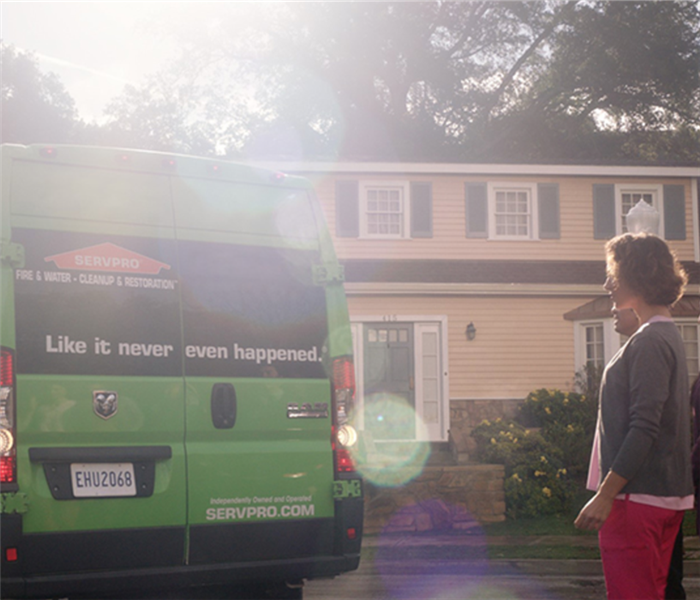 Call our SERVPRO of Punta Gorda team to create your emergency profile with the assistance of an agent.
Call our SERVPRO of Punta Gorda team to create your emergency profile with the assistance of an agent.
When a disaster hits your business in Punta Gorda, FL, you know that you have two types of financial losses: real property and business interruption. Each day of interruption brings regular business expenses as well as emergency expenses. The financial impact quickly adds up with lost daily revenues as well as the long-term effects of losing customers and employees. Because business loss insurance policies cover only so much, your key to financial survival lies in having a contingency plan and minimizing downtime.
Here’s how a SERVPRO Emergency Ready Profile can save you time in recovering from a disaster:
• Save money. There is no cost to download the ERP app or store information on your profile.
• Enhance communication. Your local SERVPRO franchise is assigned to be your disaster recovery provider.
• Save time. Setting up your emergency profile is simple. Using your tablet or mobile device facilitates documentation of necessary information and photos, enabling a quick response in the event of an emergency.
• Facilitate sharing information. You can use features in the app to easily share your emergency profile with other decision-makers and key parties at your company.
• Prioritize critical needs. SERVPRO can respond more efficiently in an emergency with knowledge of your critical areas as well as emergency information like shutoff valve location.
• Get help fast. As soon as you know the property has been damaged, you can submit your emergency through the ERP app or click to call your local franchise. Already having a complete profile means the information will be populated where needed, enabling a quicker start.
To make this process even simpler, you can call our SERVPRO of Punta Gorda team to create your emergency profile with the assistance of an agent. Having access to a reliable team of professionals at your fingertips can save you valuable time, enabling your business to recover more quickly and minimize losses. You will also benefit from working with one company that specializes in handling all your recovery needs, from mitigation to restoration, saving you from the time-consuming alternative of contacting multiple contractors.
3 Categories of Water Contamination
11/12/2021 (Permalink)
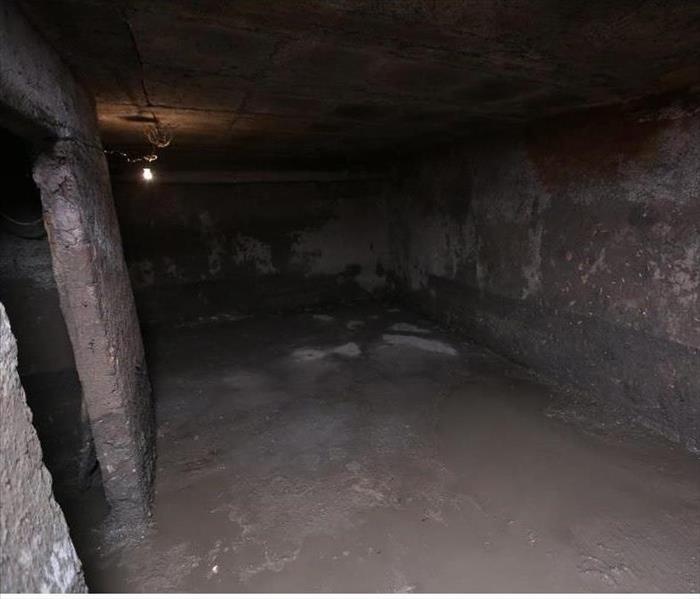 If you have contaminated water in your home, you can call SERVPRO, we are a trained team always ready to help you.
If you have contaminated water in your home, you can call SERVPRO, we are a trained team always ready to help you.
There Are Three Types Of Water Contamination.
All floods are not equal. Floodwater in your home in Punta Gorda, FL, may be clean and require nothing more than extraction and thorough drying. Other flooding may involve contaminated water that, in addition to drying, requires disinfection, preferably performed by water mitigation specialists. To determine what your remediation process should involve, you need to know which category the floodwater in your home falls under.
Contamination Factors
The water contamination level is typically determined by certain factors:
- Source of floodwater
- Materials water touches
- Time and temperature of area
Any of these factors can affect how contaminated the water flooding your home may be. Even water that is clean can become black water if certain things happen.
Category 1
Category 1 water is clean water. If a supply line breaks, the leak is most likely releasing clean water. As long as it only floods a clean floor and is taken care of in a swift manner, it will likely remain clean.
Category 2
Leaks from appliances contain contaminated water that falls within Category 2. It may be infested with contaminants, particularly if it permeates walls or flooring or has been sitting for a while in a warm area. You should avoid direct contact or ingestion of Category 2 water.
Category 3
Water in this category likely contains microbes and bacteria. Any water that comes from storm flooding, sewer water, toilet overflows or groundwater falls within Category 3. This type of flood requires professional remediation from certified experts, because you want to make sure that the area not only is dried but sanitized. You should completely avoid contact with this water.
If you have contaminated water in your home, it is best to call professionals who are trained to handle that type of remediation. Regardless of how harmless the problem may seem at first, it is better to know that the flooded area is entirely clean rather than having to guess.
Can Carpeting Be Saved After a Flood? 3 Factors To Consider
9/27/2021 (Permalink)
 If you suffer any water damage in your home, call SERVPRO
If you suffer any water damage in your home, call SERVPRO
Is It Possible To Save Carpet After A Flood? 3 Things To Think About
When flooding occurs in your Punta Gorda, FL, home, the results can be disastrous. From dealing with a pipe break to a burst water heater, assessing the water damage afterward may take some time as you sort through wet items and consider the cost of repairs. However, one item you may be unsure about replacing is wet carpeting. Before you make this decision, there are a few factors you might want to consider, as they can affect the well-being of anyone who lives in your home.
1. How Old Is the Carpeting?
A carpet's age can affect the level of damage that occurs during a flood. If the fibers are already worn, they may not absorb as much water and the carpeting may be easier to dry. However, older carpeting may shed more fibers after a flood and leave thinning or bare patches. In this case, you may want to replace it.
2. What Kind of Flood Was It?
Before you decide to remove your home's carpeting, you may want to consult a flood cleanup and restoration company. These professionals can advise you on what types of flood water may be hazardous to your health and whether your carpets can recover. For example, sewage water or flooding that occurs in your home after a heavy rain may contain pathogens and microbes that can cause serious illness. A carpet saturated with outdoor flood water cannot be salvaged, so you may want to have it torn out as soon as possible.
3. Has Mold Set In?
If it takes more than a few days to fix a pipe break and your carpeting remains wet, mold can set in quickly. Mold typically grows on the padding underneath carpeting first, so you may need to have it inspected. If no mold is present, you may be able to save affected carpeting with proper drying.
Carpeting in your Punta Gorda, FL, home can be affected by flood waters from a pipe break or torrential storm. Asking yourself a few questions about the extent of the damage can help you make the best decision possible.
3 Types of Contaminated Water
6/30/2021 (Permalink)
Types of Contaminated Water
Water damages are a frustrating and time-consuming problem. When you take into account the risks associated with contaminated water and the possibility of secondary water damage, the entire situation can be very overwhelming. It's important that you identify the type of water you're dealing with before you decide to handle any repairs on your own. Sewer backups, for example, contain black water and should only be addressed by a North Fort Myers, FL, professional.
1. Clean Water
Category 1 water is safe to handle. During a flooding situation, clean water may come from a leaky faucet or a break somewhere in the supply line. Unfortunately, if the situation isn't resolved, clean water can become contaminated and turn into category 2 or 3 water. Work quickly to thoroughly clean up and dry out your home when it is affected by clean water.
2. Gray Water
This contaminated water may cause trouble, but isn't as hazardous as black water, unless left untreated. It may carry viruses, bacteria, or urine, but it doesn't contain any feces. Overflowing toilets, dishwashers, and washing machines are some sources of gray water. Depending on what's in the water, it may be safe for you to handle this type of flooding on your own. If you aren't sure, contact a water damage specialist.
3. Black Water
The most serious of the three categories of contaminated water is black water. This type of contamination often contains untreated sewage, bacteria and viruses, chemicals, and microbial growth. Any contact with this type of water could lead to severe, lasting damages. Any water entering your home from the sewer system or from outside your home should be treated like black water.
Water damage is assessed to ensure the well-being of your family and home. Work closely with professionals who have the right training and equipment to deal with a flooding situation. You'll have lasting peace of mind, knowing that flooding has been dealt with appropriately.
6 Signs of Plumbing Trouble
5/25/2021 (Permalink)
Common Signs Of Plumbing Trouble
If you run a business in Charlotte Park, FL, the last thing you want to deal with is a problem with your plumbing system. If you experience a blocked sewer, toilet overflow or pipe break, you should contact a commercial restoration service as soon as possible. Before you have to take that step, you can familiarize yourself with these common signs of trouble.
Chronic Drain Clogging
If you experience clogs on a regular basis, it could be a sign of a problem with your cast-iron sewer lines. After 25 years, these lines can deteriorate and fail. A blocked sewer can lead to more damaging and costly issues, so it’s a good idea to address it right away.
Sewer Gas Smell
Your nose may give you another indication of trouble with your sewer lines. If you notice the odor of sewer gas, you should get your sewer system examined for damage or failure.
Continuous Flushing
A toilet overflow is a messy situation for any business. When commercial toilets won’t stop flushing, it is usually a problem with the flushometer. Most commonly, the gasket needs to be cleaned out or replaced.
Bulging Walls and Ceilings
Pipe breaks can occur when clogs or pinhole leaks go unaddressed. If you notice any swelling or protrusions in your walls or ceiling tiles, this may be the reason.
Water Stains
Another noticeable sign that water is building up in the walls is discoloration. By the time you see these stains, the leak or break is already fairly advanced and requires swift attention.
Foundation Cracks
A crack in your building’s foundation can start from root intrusion into a weak point, but once established, can expand to larger cracks. In addition to the structural damage they cause, foundation cracks can wreak havoc on water and sewage systems.
As a business owner, you don’t want to wait for a blocked sewer or pipe break to address problems in your plumbing system. By being familiar with these warning signs, you can deal with plumbing issues before they get serious.




 24/7 Emergency Service
24/7 Emergency Service







